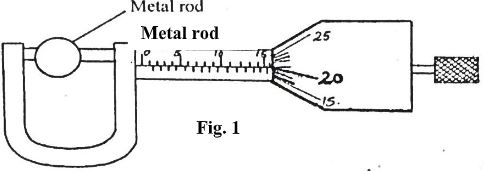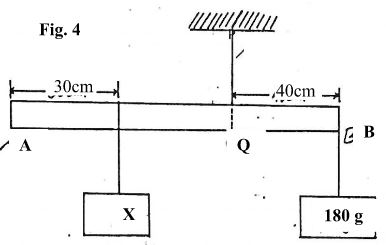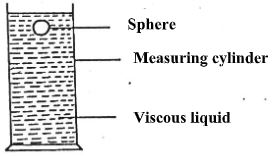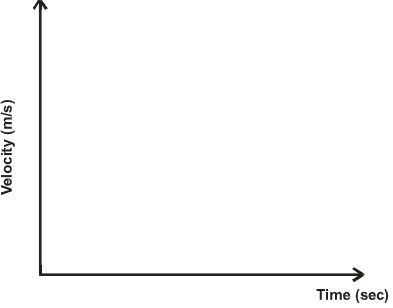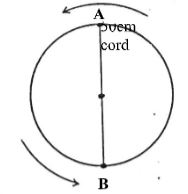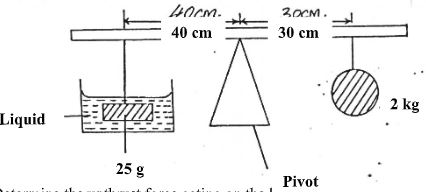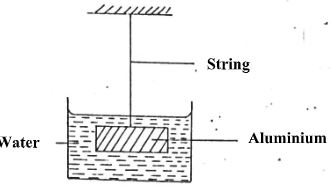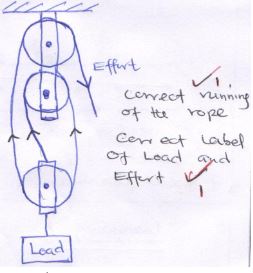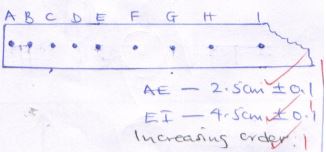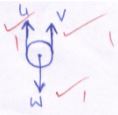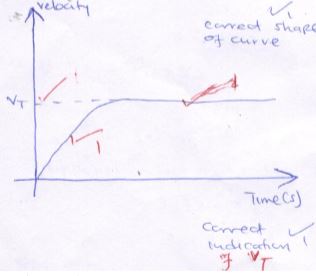Questions
INSTRUCTIONS TO CANDIDATES
- This paper consists of two sections, Section A and B.
- Answer ALL the questions in section A and B in the spaces provided.
- ALL answers and working MUST be clearly shown.
- Mathematical tables and electronic calculators may be used.
- Take acceleration due to gravity, g = 10m/s2
- Figure 1 below shows a micrometer screw gauge being used to measure the diameter of a metal rod. The thimble scale has 50 divisions.
Find the diameter of the metal rod. (1 mark) - A man of mass 72kg jumps from a small boat on to the lake shore with a forward velocity of 9.0ms-1.
If the mass of the boat is 216kg, calculate the initial backward velocity of the boat. (3 marks) - Explain briefly how the temperature in a green house is kept higher than outside. (2 marks)
The diagram shown in figure 2 below is an arrangement of three pulley wheels used to help in lifting loads. Use it to answer questions 4 and 5.Fig. 2
- Complete the diagram to show how the rope goes round the wheels, position of the load and the effort. (2 marks)
- Write down the velocity ratio (VR) of the system. (1 mark)
- State how temperature affects the speed of sound in air. (1 mark)
- State two facts which show that heat from the sun does not reach the earth surface by convection. (2 marks)
- The diagram in figure 3 below shows water with negligible viscosity flowing steadily in a tube of different cross-section area. If at a point A, the cross section area is 120cm2 and the velocity of water is 0.40ms-1, calculate the velocity at B where cross section area is 4.0cm2? (3 marks)
- A motor uses an electrical energy at a rate of 200W and raises a mass of 25kg through a vertical distance of 20m in 0.5 minutes. Determine the efficiency of the motor. (3 marks)
How long will it take 240V, 3000W electric immersion heater to raise the temperature of 150 litres of water in a well-lagged calorimeter made of copper of mass 20kg from 15° to 70°C? (3 marks) - The diagram shown in the Figure 4 below shows a system in equilibrium with the rule horizontal. AB is a uniform rule of length 1.0m and weight 1.8N. Calculate the weight of the block X. (3 marks)
- State the reason why a trailer carrying heavy loads has many wheels. (1 mark)
SECTION B (55 MARKS)
Answer ALL the questions
- A student in Anestar Girls set up an experiment to study the acceleration of a trolley using ticker tape timer. The timer made 50 dots per second on the tape. Dots A to E measured 2.5cm apart and dots E
to I measured 4.5cm apart.- Using a scale drawing show the dots A, B C, D, E, F, G and I as they appeared on the tape. (3 marks)
- Determine the velocity of the trolley from:
- A to E. (2 marks)
- E to I. (2 marks)
- Calculate the acceleration of the trolley. (2 marks)
- What end of the tape was fixed onto the trolley? (1 mark)
- State two precautions that the student should take before she takes her final samples of the dots. (2 marks)
-
-
- What is Brownian motion? (1 mark)
- Describe with the aid of a diagram, the apparatus you could set up in order to demonstrate Brownian motion of smoke particles suspended in air. (5 marks)
- An oil drop has a volume of 0.01mm3 when it is placed on the surface of some water, it spreadsout to form a circular patch of area 500cm2
- Calculate the thickness of the oil film. (3 marks)
- What two assumptions have you made in the answer b(i) above. (2 marks)
-
-
-
- Distinguish between inelastic and elastic collisions. (2 marks)
- A particle A of mass M moving with an initial velocity, u, makes a head-on collision with another particle B of mass 2M, B being initially at rest. In terms of u, calculate the final velocity of A if the collision is perfectly inelastic. (3 marks)
- The diagram in Figure 5 below shows a sphere moving in a viscous liquid in a tall measuring cylinder.
- Show on the diagram the forces acting on the sphere. (3 marks)
- Sketch a graph showing the variation of velocity with time in figure 6 below. Show on the graph the terminal velocity, VT. (2 marks)
-
- A mass of 1kg is attached to a cord of length 50cm. It is whirled in a circle in a vertical plane at 10 revolutions per second as shown in the figure below.
- Find the tensions in the cord when the mass is at:
- Highest point of the circle A. (2 marks)
- Lowest point of the circle B. (2 marks)
-
- Describe an experiment to determine specific heat capacity of aluminium block with two holes drilled in it to accommodate a thermometer and an electric heater. (5 marks)
- An immersion heater rated 90W is placed in a liquid of mass 2kg. When the heater is switched on for 15minutes, the temperature of the liquid rises from 200C to 30°C. Determine the specific heat capacity of the liquid. (3 marks)
- Find the tensions in the cord when the mass is at:
-
- The figure below shows a block of mass 25g and density 200kg/m3 submerged in a certain liquid and suspended from a homogenous horizontal beam by means of a thread. A mass of 2kg issuspended from the beam as shown in the figure below.
- Determine the upthrust force acting on the block. (3 marks)
- Calculate the density of the liquid. (3 marks)
-
- State the law of floatation. (1 mark)
- The figure below shows a piece of aluminum suspended from a string and completely immersed in a container of water. The mass of the aluminium is 1kg and its density is 2.7 103kg/m3
Calculate the tension in the string. (3 marks)
- The figure below shows a block of mass 25g and density 200kg/m3 submerged in a certain liquid and suspended from a homogenous horizontal beam by means of a thread. A mass of 2kg issuspended from the beam as shown in the figure below.
Marking Scheme
- 16.21mm✔1 correct answer with correct units
Accept 1.621cm or 0.01621m - Momentum is conserved momentum before = momentum after
72 9 = 216 4✔1
⇒ u = 72 × 9
216✔1
= 3.0m/s✔1 - Roofing materials allows radiations to penetrate into the greenhouse✔1 but not out. Higher concentration of carbon dioxide inside the greenhouse helps to retain higher temperature by trapping/ insulating✔1 the heat.
-
- V.R = 3✔1
- Increase in temperature increases✔1 the speed of sound.
-
- Convection takes place in air upwards direct due to✔1 to density defect.
- Convection requires a ✔1 material medium but the space between the sun and the earth i.e. space of the atmosphere has no material medium
- From the equation of continuity
A1U1 = A2U2✔1(flow rate is constant)
120 0.4 = 4 U2
∴ U2 = 120 ×0.4
4✔1
= 12 ms-1✔1 - Work done on the mass
= force distance
= 25 x 10 x 120
= 5000J.✔1
Work done = power time
= 200 x 30✔1
= 6000J✔1
But = work output x 100
work input
= 5000 x 100
6000
= 83.3% ✔1 - ΔH = MCΔθ
= 150 ×1000×4200 ×70-15 +
1000
390 ×20×70-15
= 34650.000 + 429000
= 463650✔1
Energy dissipation E = pt
3000 ×t=4636501
⇒t = 463650 = 154.55 sec✔1
3000 - At balance
Sum of clockwise = sum of anti-clockwise moments
(180/1000×100) 40 = 30 x X + (10×1.8)✔1
1.840 = 30X +18
X = 1.8 ×40-18✔1
30
= 1.8N✔1 - To increase surface area of contact thus reducing pressure exerted on the road✔1
-
-
-
- Velocity = displacementtime
= 2.5
4×0.02✔1
= 31.25cms-1✔1 OR0.3125ms-1 - E to I
Velocity = 4.5
4 ×0.02✔1
= 56.25 cms-1✔1
- Velocity = displacementtime
- a = u-ut
= 0.5625-0.3125
0.02 ×8
= 0.25 = 1.5625ms-2
0.16 - End A✔1
-
- Trolley runs on a straight path on the runway✔1
- Tape lies flat on the horizontal surface. ✔1
-
-
-
- Brownian motion is the continuous erratic/ random motion in either gas or liquid molecules✔1
-
- A small glass with air and carbon (smoke) particles✔1
- the glass cell is strongly illuminated by a filament lamp directed by a perspex rod✔1
- the particles scatter light and they can be viewed through a microscope✔1
- they appear as bright specks (spots) moving with the same irregular random motion
-
- V= r2h
0.01 (10-3)3= 3.14 r2h✔1
h = 0.01 × 10¯⁹
3.14 × r2✔1
= 0.01 × 10¯⁹ u = 2 x 10-10m ✔
500× 10-4 -
- Oil spreads to form a monolayer✔1
- Oil patch formed is exactly circular. There is no evaporation of oil molecules movement/ spreading ✔1 of the oil molecules are elastic.
- V= r2h
-
-
-
-
- In elastic collision – K.E and momentum of the objects are conserved✔1
- Elastic collision – only momentum is conserved✔1
- Initial momentum = Final momentum
- 2MBUB + MAUA = 3MV✔1
0 + MUA = 3Mu✔1
3Mu = MU
u - MU/3M
= u/3 ms-1✔1
- 2MBUB + MAUA = 3MV✔1
-
-
-
-
-
-
- ω = 2f
= 2π× 10
= 20rad s-1
= 62.83 rad-1
TA = M ω2r – mg
= (1×62.832 ×0.5)- (1×10)✔1
= 19 + 3.9 – 10
= 1963.9N✔1 - At the lowest point
Fc = T – Mg
⇒ Fe + Mg
= mr ω2 + mg
= 1 x 0.5 x 62.832 + 1×10✔1
= 1973.9 + 10
= 1983.9N✔1
- ω = 2f
-
-
- Electric heater is switched ✔1 on.
- Time is obtained for a certain temperature rise✔1
- Mass of block is obtained✔1
pt = MCθ
c = pt/Mθ✔1
- pt = MCΔ
⇒C= pt/MCθ
= 90×15 ×60
2 × 30-20✔1
= 81000
2 ×10✔1
= 4050JKg-1k-1
-
-
-
-
- ∑C.m = ∑ A.C.M
40(0.25 - u) = 30 20✔1
10 – 40u = 600
40u - -590
U = -590/40✔1
= - 14.75N✔1
∴ u = 14.75 (acting upwards) - U = wgt of liquid displaced
14.75 = mg
= v ×ρ g
Vol of liquid displaced = vol of block
= Mb/Pb
= 25/1000×200 = 0.00125✔1
∴ 14.75 = 0.00125 ×ρ×10
⇒ ρ = 14.750.00125 ×10✔1
= 1180kgm-3✔1
- ∑C.m = ∑ A.C.M
-
- A floating object displaces its own weight of the fluid on which it floats✔1
- Tension + Upthrust = weight
Upthrust = wgt of H2O displaced
Vol. of H2O displaced = vol of aluminium
= Mass of aluminium = 1
Density of aluminium 2.7 ×10-3
= 3.7 10-4 m3✔1
Mass of H2O = ρwυw
= 1000×3.7×10-4
= 3.710-1kg
∴upthrust = wgt of H2O displaced
= 3.710-1×10
= 3.7N✔1
Since T + U = W
T = W – U
= Mg – U
T = (10 ×1) – 3.7
= 6.3N✔1
-
Download Physics Paper 1 Questions and Answers - Moi Tea Mock Examinations 2022.
Tap Here to Download for 50/-
Get on WhatsApp for 50/-
Why download?
- ✔ To read offline at any time.
- ✔ To Print at your convenience
- ✔ Share Easily with Friends / Students

